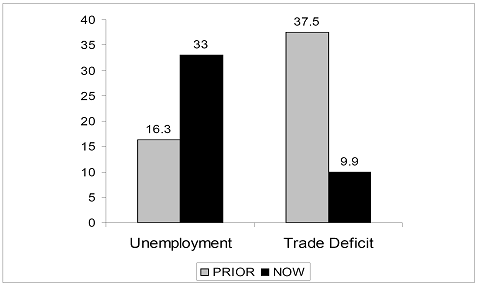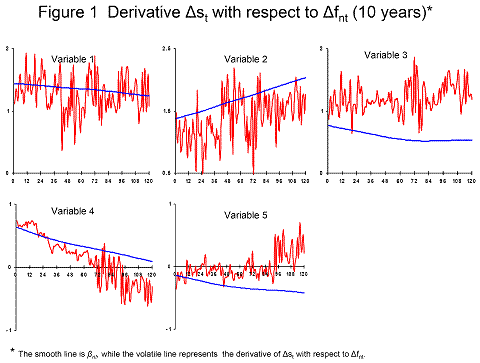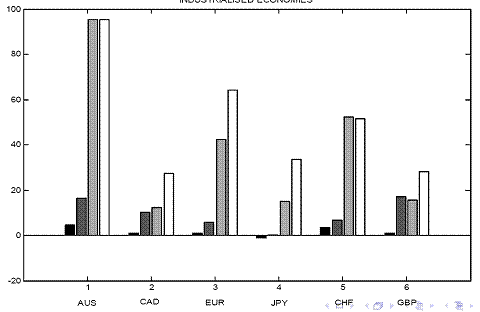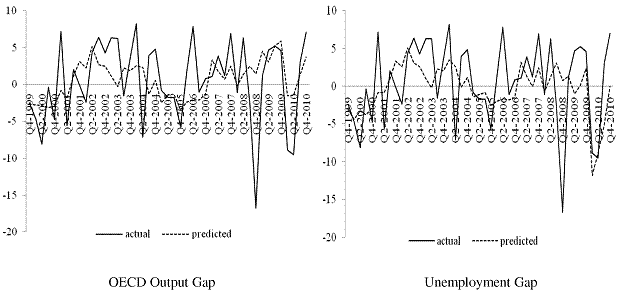Or, at least one session’s worth of recent thinking on the topic.
Presiding: Philippe Bacchetta (University of Lausanne)
On the Unstable Relationship between Exchange Rates and Macroeconomic Fundamentals, by Philippe Bacchetta (University of Lausanne), and Eric van Wincoop (University of Virginia). Discussed by Ken Kasa (Simon Fraser University).
- Order Flow and the Monetary Model of Exchange Rates: Evidence from a Novel Data Set , by Menzie Chinn (University of Wisconsin), and Michael Moore (Queen’s University Belfast). Discussed by Pierre-Olivier Gourinchas (University of California-Berkeley)
- Phoenix Taylor Rule Exchange Rate Forecasting During the Financial Crisis, by David Papell (University of Houston), and Tanya Molodtsova (Emory University) . Discussed by Jan Groen (Federal Reserve Bank of New York).
- The Scapegoat Model of Exchange Rates: An Empirical Test, by Marcel Fratzscher (European Central Bank), Lucio Sarno (Cass Business School), and Gabriele Zinna (Bank of England). Discussed by Nelson Mark (University of Notre Dame).
This session was notable for bringing together papers that focused on the inability of our empirical models to explain satisfactorily movements in key bilateral exchange rates. One overarching theme was that parameter variability was something to take seriously, and not necessarily as a nuisance.
From On the Unstable Relationship between Exchange Rates and Macroeconomic Fundamentals:
It is well known from anecdotal, survey and econometric evidence that the relationship between the exchange rate and macro fundamentals is highly unstable. This could be explained when structural parameters are known and very volatile, neither of which seems plausible. Instead we argue that large and frequent variations in the relationship between the exchange rate and macro fundamentals naturally develop when structural parameters in the economy are unknown and change very slowly. We show that the reduced form relationship between exchange rates and fundamentals is driven not by the structural parameters themselves, but rather by expectations of these parameters. These expectations can be highly unstable as a result of perfectly rational “scapegoat” effects. This happens when parameters can potentially change much more in the long run than the short run. This generates substantial uncertainty about the level of parameters, even though monthly or annual changes are small. This mechanism can also be relevant in other contexts of forward looking variables and could explain the widespread evidence of parameter instability found in macroeconomic and financial data.
In van Wincoop’s presentation, the authors motivate the scapegoat interpretation by reference to a finding by Cheung and Chinn (JIMF, 2001), in which survey (forex traders) respondents compare what factor is most important at the time of survey (1998) to a period five years earlier (1993):

Figure 0 from Cheung and Chinn (JIMF, 2001) via Bachetta and van Wincoop presentation.
The authors simulate the scapegoat model; in Figure 1, the simulated elasticities with respect to macro variables (red) and the actual elasticities (blue) are shown.

Figure 1: “Derivatives”, from On the Unstable Relationship between Exchange Rates and Macroeconomic Fundamentals.
The implied parameters are much more variable than the underlying parameters, consistent with the scapegoat model. The author’s conclude:
While our focus has been on the exchange rate, an analogous explanation could also account for the extensive evidence of parameter instability seen in other forward looking macroeconomic and financial data. Two key ingredients, which are not limited in any way to exchange rate models, drive our unstable reduced form results. First, there must be unobserved fundamental shocks. This applies surely to other asset prices as well and more generally to other macroeconomic data as factors driving business cycles and long term growth rates are not perfectly understood. Second, structural parameters must have the potential to change significantly over long horizons. This would be hard to dispute as well, especially in the context of major technological, financial and institutional changes over the past two centuries.
The discussant, Ken Kasa, noted in his presentation that while the idea imbedded in the Bachetta-van Wincoop approach was straightforward, the implementation was computationally intensive. He proposed using an extended Kalman filter, where the innovation would be” to recursively linearize the system around current state estimate in order to update state estimates, but propagate the system forward using the original nonlinear system.” The authors concurred, noting that this had been their intention.
In The Scapegoat Model of Exchange Rates: An Empirical Test, Fratzscher, Sarno and Zinna confront the model implications with data. In particular, they test two hypotheses.
Hypothesis #1: Scapegoat model outperforms benchmark models:
- two benchmarks (constant parameter; time-varying parameter models).
- strong support along three performance criteria (goodness-of-fit, information, market-timing test).
- robustness; and for all 12 currencies.
Hypothesis #2: Determinants of scapegoats
- theory: fundamental becomes scapegoat if size of deviation from equilibrium large and there is sizeable shock to unobservables.
- empirical: strong and robust evidence, for all currency groups and for all macroeconomic variables.
The authors examine these two hypotheses using a remarkable data set that includes 8 years of survey data on the relative importance of macro variables, as well as order flow data (the latter proxies for unobservable shocks to macro variables). They evaluate the goodness of fit of a constant parameter, time varying parameter, a scapegoat model with no order flow, and a scapegoat model with order flow. The adjusted R2’s for six major currency pairs is illustrated in Figure 2 below:

Figure 2: Adjusted R2’s for Australian dollar, Canadian dollar, Euro, Japanese yen, Swiss Franc, and British pound, all against the US dollar; for constant parameter (black bar), time varying parameter (dark gray bar), scapegoat model without order flow (gray bar), and scapegoat model with order flow (white bar).
Fratzscher concludes:
Based on novel survey measures of FX scapegoats for 12 currencies, and proprietary order ‡ow data (unobservables), we find empirical evidence that strongly supports the empirical implications of the scapegoat theory:
- The scapegoat model outperforms (in-sample) two benchmark models for a large number of countries and across three performance criteria.
- Both the scapegoat and order flow are important, and their relative contributions vary across countries and time.
- A macroeconomic fundamental is picked as a scapegoat at times when it shows large movements combined with large changes in the unobservable.
The discussant Nelson Mark observed that this approach nested the paper by Chinn and Moore (discussed below) because it incorporates order flow (proxying for unobserved macro variables) as well as scapegoat effects.
In Order Flow and the Monetary Model of Exchange Rates: Evidence from a Novel Data Set , Chinn and Moore augment a standard monetary model of exchange rates with eight years of order flow data.
We propose an exchange rate model which is a hybrid of the conventional specification with monetary fundamentals and the Evans-Lyons microstructure approach. We argue that the failure of the monetary model is principally due to private preference shocks which render the demand for money unstable. These shocks to liquidity preference are revealed through order flow. We estimate a model augmented with order flow variables, using a unique data set: almost 100 monthly observations on inter-dealer order flow on dollar/euro and dollar/yen. The augmented macroeconomic, or “hybrid”, model exhibits greater in-sample stability and out of sample forecasting improvement vis a vis the basic macroeconomic and random walk specifications.

Figure 9: from Chinn and Moore (2010)
This paper is discussed at greater length in this post.
The discussant, Pierre-Olivier Gourinchas, observed in his comments that he is unsure that how order flow represents preference shocks. In other words, since decentralized trading is not explicitly modeled, it is unclear why the preference shock is not fully revealed in the price (the exchange rate). He also questions what information can be gleaned from the 96 monthly observations in the sample.
Finally, in Phoenix Taylor Rule Exchange Rate Forecasting During the Financial Crisis, the authors revisit the predictive power of Taylor rule fundamentals in exchange rate determination.
This paper evaluates out-of-sample exchange rate forecasting of Taylor rule models for the euro/dollar exchange rate with real-time data during the financial crisis of 2008-2009. The Taylor rule specifications outperform the random walk with forecasts ending between 2007:Q1 and 2008:Q2, but the evidence weakens in 2008:Q3 and falls precipitously at the peak of the crisis in 2008:Q4. Taylor rule forecasting, however, rises from the dead in 2009 and 2010. We also compare the out-of-sample performance of the Taylor rule specifications with conventional models. The model with interest rate differentials can only outperform the random walk before the crisis, and the monetary and purchasing power parity models cannot outperform the random walk for any forecast interval.

Figure 2: (excerpt), actual and predicted euro/dollar exchange rate changes, from Molodtsova and Papell (2010).
The discussant, Jan Groen, observed in his presentation that Taylor rules implied more than just a relationship to the output gap (or unemployment gap) and the inflation gap. It also implied certain values on the parameters (including the restriction that in the Taylor rule equation, the coefficient on inflation is greater than 1 — otherwise there would be no correction back toward the inflation target. This restriction is not incorporated into the exchange rate equation. Indeed, the derivation of the exchange rate equation is ad hoc, incorporating the stylized fact that higher interest rates induce a stronger currency.
Groen’s view is that the model breaks down because of extraordinary movements in an omitted variable, namely a risk premium, amplified by funding problems in financial institutions. Using balance sheet variables in a dynamic factor approach, he shows that there was a large UIP deviation which he interprets as a risk premium. This factor, from Adrian, Etulo and Groen (2010).

Figure 3: from Groen presentation.
There were other sessions on exchange rates I didn’t get to; here’s an non-exhaustive list:
Predicting Exchange Rates (F3)
- Factor Model Forecasts of Exchange Rates, by Charles Engel (University of Wisconsin), Nelson C. Mark (University of Notre Dame),
Kenneth D. West (University of Wisconsin).
- Yield Curve Predictors of Foreign Exchange Returns, by
Andrew Ang (Columbia University), Joseph C. Chen (University of California-Davis)
- What Moves Real Exchange Rates? by Jules H. van Binsbergen (Stanford University), Ralph S.J. Koijen (University of Chicago),
Brent Neiman (University of Chicago)
- Countercyclical Currency Risk Premia, by Hanno Lustig (University of California-Los Angeles), Nikolai Roussanov (University of Pennsylvania), Adrien Verdelhan (Massachusetts Institute of Technology)
Real Exchange Rates (F4) (Econometric Society)
- What Determines European Real Exchange Rates? by Martin Berka (Massey University, New Zealand), Michael B. Devereux (University of British Columbia),
- Accounting for Real Exchange Rate using Micro-Data, by Mario Crucini (Vanderbilt University and NBER), Anthony Landry (Federal Reserve Bank of Dallas),
- The Dynamics of Market Power and International Prices, by Allen C. Head (Queen’s University), Beverly J. Lapham (Queen’s University)
Exchange Rates (F3)
- Portfolio Reallocation and Exchange Rate Dynamics, Liang Ding (Macalester College), Jun Ma (University of Alabama)
- Model Selection Testing for Diffusion Processes with Applications to Interest Rate and Exchange Rate Models, by Hwan-sik Choi (Purdue University), Minsoo Jeong (Indiana University), Joon Park (Indiana University)
- What Determines European Real Exchange Rates? by Martin Berka (Massey University), Michael B Devereux (University of British Columbia)
- Limits to Arbitrage During the Crisis: Funding Liquidity Constraints and Covered Interest Parity, by Tommaso Mancini-Griffoli (Swiss National Bank), Angelo Ranaldo (Swiss National Bank)
- What Drives the Dollar-Oil Correlation? by Christian Grisse (Federal Reserve Bank of New York)
You can access some of the papers at the AEA website for the conference (searchable agenda).
The modesty in their address, of the academic papers turns to be a diplomatic effort to explain the irrational.One may “like” better political statements on currencies “too low” “too strong”, or financial loud speakers “must go up” or “must go down”
Pragmatic, the flows approach is a trial and error process towards reality.They are embedded axioms of linearity, when the underlying world of foreign exchange is built on a chaos. A benchmark exchange rate value, disconnected with the trade,service or real financial transaction (Econbrowser Chinn-Ito Capital Account Index up to 2008,Prospects for Growth And Rebalancing, The BIS on Global Forex Trends)
Submissive, the models tend to approve the flows as they are, that is inter banks transactions and assumed foreign exchange relationship with current accounts. They are long way gone.The flows approach is the Faraday plaque in chemistry, without the electrodes.
Lately the Federal reserve chairman said “they are flaws in the usd definition” They are as well many flaws in other currencies.
Menzie, very interesting and thanks for the summary. Too bad that I could not make to your session coz I was discussing an exchange rate paper in a session parallel to yours.
Menzie: Thanks a lot for this very helpful post.
Anyone who actually has a model of exchange rates that works will be fabulously wealth in short order. Do any of the participants in this AEA seminar meet the criteria?
Thanks for this very informative post, Menzie.
I get depressed by the proportion of macroeconomists who ignore the possible impact of terms of trade shocks on exchange rates. Any idea why this persists? You’d think that this would be important for *some* exchange rates…..
The Momeneum hypothesis recently discussed by the Economists magazine is a likely candidate.
As noted by the magazine, this hypothesis works well for a considerable time, then it doesn’t.
Jian: Thanks — that’s the way it goes at ASSA. Too many interesting sessions going on at once.
David L. Kendall: I believe you both misapprehend the mission of economics, which focuses on understanding why economic variables behave the way they do, and only secondarily, on prediction/forecasting.
Simon van Norden: I think Fratzscher wanted to retain consistency across currencies, and I suspect that the survey data (Consensus Forecasts) did not include prioritization for commodity prices on a consistent basis — which is necessary for the tests. On the other hand, I do think Chen and Rogoff [a] have done a lot to bring in commodity prices into the exchange rate literature, especially with respect to CAD, AUD, and NZD.
Reformer Ray: Momentum has been loomed large in the practitioner literature, but not so much in the economics literature, as it’s not a “fundamental” per se. On the other hand, formalizing the momentum effect is a challenge; I tend to think of incorporating momentum in the Chartist/Fundamentalist framework of Frankel and Froot.